#Indonesian archipelago
Explore tagged Tumblr posts
Text
So proud of my collaborator & business partner Thom for this very important essay via Reactor on the Marvel Cinematic Universe's Madripoor, a fictional city they've now set in Indonesia. Please read, please share & learn some history from a member of the Indonesian diaspora who beautifully weaves in his own family's difficult life experiences into this article about how Southeast Asia is depicted.
Please share, because I didn't know the Indonesian history Thom shares here and I find that tragic. Learn something new today!
#marvel#marvel mcu#mcu#comics#indonesia#indonesian#history#diaspora#southeast asia#southeast asian history#archipelago#personal essay#essay#essay writing#discussion#academics#narrative#orientalism#media critique#commentary#diversity#wwii history#wolverine: madripoor knights#madripoor#orientalist#internment camp
8 notes
·
View notes
Text

????????????????????????
#tags edited in about half an hour later#i have been informed that Tukang Besi means metalsmith in malay and indonesian#and that the archipelago where speakers of the Tukang Besi language live is known for that#so that explains why that came up while i was trying to search for the language
1 note
·
View note
Text

gravity falls — malay archipelago!AU
This AU is based off the maritime trading period of malay and indonesian culture + folklore.
in this AU, stanley pines is a fraud fortune teller/conman and mabel & dipper sailed down straits of malacca for the monsoon season at their grunkle's 'kampong misteri'.


ummmm yeahhhh silly doodles teehee :3
523 notes
·
View notes
Text
Rin, Kabru, & Toshiro: On Asian Identity
I have a lot of thoughts about Rin's identity as a second-generation Asian refugee and how it impacts her relationships with other characters, especially Kabru.
I see Rin as being Indonesian specifically. The name "Rinsha" is of Muslim Arabic origin. In real life, Indonesia has one of the largest Muslim populations in the world, so what might seem like a geographically incompatible name works if Rin is the Dungeon Meshi equivalent of Indonesian.
Rin also says that her parents came from an island that isn't Wa, and Indonesia is a series of islands.
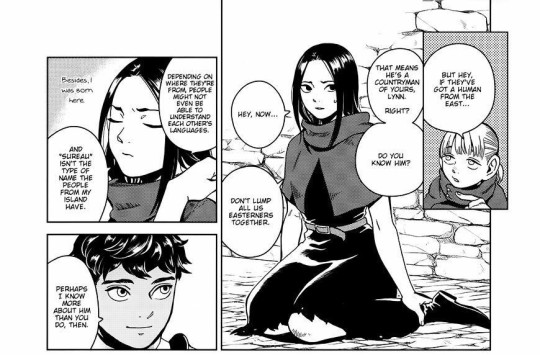
In her Adventurer's Bible entry, she's described as having "no real knowledge or attachment to the East" because "she's second-generation." She also clarifies to Mickbell that she was "born here." From this character description and her dialogue, we get the sense that Rin doesn't really identify with being Asian.

As noted in this Rin masterpost, a large part of this is because she was denied her parents' cultural identity by the elves. They likely suppressed any cultural markers she had and denied her information about her heritage. Since she wasn't born in the Eastern Archipelago and her parents died when she was young, she understandably hasn't inherited a lot of cultural knowledge.
Rin seems to have internalized ethnic self-hatred. Her disconnect from the East and her unwillingness to remedy that disconnect suggests that she has shame surrounding her Asian identity.
Again, she doesn't have many opportunities to interact with people from her parents' homeland, and her trauma also impacts her behavior. Remembering her parents is probably painful, considering the horrible way they died, and since they're her main connection to her cultural heritage, it makes sense that she wouldn't broach the topic.
You could also argue that Rin identifies more with her Northern identity than her Eastern identity since she was born and raised in the North for the first eleven years of her life, and as a result, she doesn't feel the need to connect with her parents' culture. But considering her home was presumptively still steeped in her parents' culture and her main association with the North is probably her parents' murders, this seems unlikely.
It's important to note how different her experiences are from the story's other Asian characters', like Toshiro's, for example. Toshiro travels to the Island as an adult of his own volition (technically, his father's). He's completely culturally Eastern. In comparison, Rin's parents fled from the East. Her family had to assimilate into an unfamiliar Northern culture, and later, she was "raised" by western elves, who are coded as colonizers in text. She seems to have internalized the elves' suppression of her culture and the way assimilating to the North required them to discard parts of their heritage. Her lack of interest in her culture seems learned.
Her strong attachment to Kabru further complicates her relationship with her Asian identity. I see Kabru as Indian or Nepalese; his name derives from a mountain on the border between India and Nepal. On top of being the only person who treats her like a human being during her childhood, Kabru is the only other significant Asian person in her life. They share the trauma of their parents having been brutally murdered and being raised imperfectly (much more severely in her case) by elves. While in the elf's care, they're both othered as tallmen— this aspect is strongly emphasized in the text — and in the main story, they're othered as Asian people in its European-inspired setting. Their shared experiences as Asian refugees are the foundation of their close bond.
It's not a stretch to assume that Rin consequently views Kabru as her main connection to being Asian. While they're from very different parts of fantasy Asia, their experiences as Asian refugees still overlap significantly as seen above, and the way she clings to Kabru suggests she wants to connect more with her culture, but for the previously stated reasons, she doesn't prioritize it. Besides, she doesn't have good models for what embracing one's cultural identity as a refugee/immigrant looks like. Just like her, Kabru doesn't seem to have many cultural ties, similarly because of his upbringing with the elves.
Toshiro could completely topple Rin and Kabru's original dynamic. Rin doesn't seem to like Toshiro. Their personalities would probably clash at first, because just like him, she's prone to judgment, out of self-preservation, and she's quiet. One of their canonical interactions is being captured by the orcs together; they don't even speak to each other in this scene.

Kabru and Toshiro become friends by the story's conclusion. Deep down, Rin might feel threatened by this. She's been Kabru's closest Asian friend up until this point. Toshiro, as an Asian person who was born and raised in his culture, might seem like a "better Asian" and thus, Kabru's replacement for her. This would be the worst projection of her buried insecurity over her disconnect from being Asian and how it potentially separates her from other Asian people. Given her personality, I doubt she would express this beyond acting wary around Toshiro.

With time, Rin, Kabru, and Toshiro could resolve her fears and the deeper issues they point to by all becoming friends. Interacting with other Asian people would heal her. She appears unphased by Mickbell's microaggression, implying it isn't an uncommon occurrence; she seems to only hang out with Kabru and their party. Being around other people of color would lessen the amount of othering she experiences and grant her a break from defending her identity.
Beyond the potential for cultural exchange and bonding over being Asian in fantasy Europe, Rin and Toshiro are also very similar in character. They're both anxious, quiet, and caring. If they made a little effort, they'd relate to each other and get along well.
Ideally, Rin would also befriend Hien, Benichidori, and the other girls in Toshiro's party. Kabru and Toshiro have their own issues with their treatment of women, so without positive Asian female friendships, she'd have another issue on her hands. Still, Kabru could be the bridge to a friendship with Toshiro, and Toshiro could be the bridge to friendships with his retainers. And with mutual growth, they could all enjoy each other's friendships.
Rin herself points out the vast cultural differences and language barriers between different parts of the East. The Asian characters of DunMeshi might not always share culture, but because of the story's setting in fantasy Europe, many of them experience being nonwhite in a mostly white locale. A support system of other people of color could allow Rin the space to explore her identity and culture and begin healing from her childhood trauma.
#rinsha fana#rin dungeon meshi#dungeon meshi#dunmeshi meta#kabru#toshiro nakamoto#shuro#kabru of utaya#my silly thoughts abt rin but also just me heavily projecting other asian am ppl in my life onto dunmeshi charas#love rin dearly#it's so important to me that all the asian charas become friends and bond over being asian#dunmeshi#delicious in dungeon#*mine#*meta
167 notes
·
View notes
Photo

The Early History of Clove, Nutmeg, & Mace
The spices clove, nutmeg, and mace originated on only a handful of tiny islands in the Indonesian archipelago but came to have a dramatic, far-reaching impact on world trade. In antiquity, they became popular in the medicines of India and China, and they were a major component of European cuisine in the medieval period. European countries fought mightily for control of the spice trade.
Natural History
The name clove refers to the dried, unopened buds of the evergreen tree, Syzygium caryophyllata in the myrtle family. Cloves were native to only five tiny, volcanic islands in the East Indian Archipelago: Ternate, Matir, Tidore, Makian, and Bacan, all belonging to the Maluku Islands or the Moluccas.
The nutmegs are the dark reddish-brown seeds within the fruits of Myristica fragrans, of the Myristicaceae family. These seeds are surrounded by a deep red, fleshy net-like membrane, or aril, which is the mace. The nutmeg tree was native to sheltered valleys on the hot, tropical Banda Islands in the Maluku region of Indonesia.
Continue reading...
46 notes
·
View notes
Text
The Raja Ampat archipelago is part of the Indonesian province of West Papua and consists of over 1,500 islands.
1K notes
·
View notes
Note
hiii i hope the request still opens and sorry to distrubed you, can i request for Indonesian Yuu? I love how you show people's unique culture from their country and how you introduce them, thank youu ❤❤
Grim:
“Wait, so you can eat rice every day and not get bored? How do you do it?”
Freaks out over the different types of sambal (chili paste).
“Is it true that you guys have like a million ways to prepare fried rice?”
The NRC Student Body:
“You guys have so many islands, do you ever get lost?”
“What’s up with all the street food? Do you live off that stuff?”
“Is it true that Indonesian spices can make you feel things?”
Crowley:
“Ah, Prefect, Indonesia! A land of great diversity, I’m sure. Tell me, how does one survive such a vast archipelago?”
Uncertain how to pronounce rendang, but still insists it’s a “very exotic” dish.
Tries to convince Yuu that their culture is a mix of everything.
Heartslabyul:
Riddle Rosehearts:
“Wait, so in your country, you have these really colorful festivals with… dragons?”
Doesn’t believe that rice truly is a staple food and asks why it’s eaten so much.
Ace Trappola:
“Spicy food is your thing, huh? I can handle it!”
The first time he tries sambal, he’s sweating and crying but still impressed.
Deuce Spade:
“So, your traditions are all about family, food, and festivals? Sounds like a lot of fun.”
Absolutely loves learning about Indonesian holidays, especially Nyepi (the Day of Silence).
Trey Clover:
Tries to replicate Indonesian dishes and almost gets it right.
Is fascinated by the diversity of Indonesia’s cuisine—loves nasi goreng and satay.
Cater Diamond:
Thinks Indonesia is exotic and “super cool.”
Gets caught up in trying to take a picture of every Indonesian dish Yuu shares.
Savanaclaw:
Leona Kingscholar:
“You’re from an archipelago? So, it’s all islands and ocean, huh? How do you even keep track of where you are?”
Wonders why they’re always drinking iced tea (es teh).
Ruggie Bucchi:
Enjoys the food, especially bakso (meatball soup).
“Your country’s all about the hustle, huh? I can vibe with that.”
Interested in the gotong royong (mutual cooperation) concept.
Jack Howl:
Fascinated by Indonesian culture’s respect for nature.
Tries learning Indonesian phrases but fails miserably.
Octavinelle:
Azul Ashengrotto:
“You come from an island paradise with a rich culture? Intriguing.”
Enthralled by the concept of Indonesian spices, and loves trying different kinds of sambal.
Considers offering Indonesian food at his lounge—though he worries about the spice levels.
Jade Leech:
Enjoys the tropical fruit and coffee from Indonesia.
“The tropical climate must make your country an absolute treasure trove of flora and fauna.”
Very interested in the wayang kulit (shadow puppet) performances.
Floyd Leech:
Absolutely obsessed with Indonesian chili and spicy food.
Finds the customs and superstitions of Bali to be “strange but interesting.”
Scarabia:
Kalim Al-Asim:
Enthusiastically asks Yuu to teach him how to make nasi goreng (fried rice) and sate (grilled skewers).
Loves the idea of bazaar (markets) and Indonesian street food.
Jamil Viper:
Thinks Indonesian culture is beautiful, especially its various dances and music.
Tries to recreate the rendang dish, but it’s never quite as perfect as Yuu’s.
Ignihyde:
Idia Shroud:
“Wait… Indonesian mythology? Is it like… a whole world of demons?”
Freaks out over the kris (traditional Indonesian dagger) and is interested in its legend.
Obsessed with Indonesian video games and virtual idols.
Ortho Shroud:
“There are so many islands in your country… how do you remember them all?”
Loves the idea of Indonesian technology advancements but is more excited about the Gamelan music (traditional Indonesian orchestra).
Diasomnia:
Malleus Draconia:
“A land of great cultural richness… your people’s reverence for nature is inspiring.”
Finds the Barong dance fascinating and wants to know more about Indonesia’s mythical creatures.
Lilia Vanrouge:
“I heard you celebrate Hari Raya (Hari Lebaran)? I wonder what the food’s like…”
Very interested in the Indonesian concept of gotong royong, where people come together to help one another.
Silver:
Absolutely loves the Indonesian landscape. “So, you have mountains and beaches at the same time?”
Enthralled by Indonesian traditions and holidays.
Sebek Zigvolt:
“Your country has so many powerful mythological creatures! I love the stories about them!”
Completely lost when trying to speak in Bahasa Indonesia, even though he keeps trying.
Pomefiore:
Vil Schoenheit:
“Your people value natural beauty, yes? I’m sure their skincare game is on point.”
Curious about Indonesian fashion trends.
Thinks Indonesian batik prints are absolutely beautiful.
Rook Hunt:
“Ah, Indonesia! You have an incredibly deep cultural history—how lovely!”
Obsessed with the art of wayang kulit (shadow puppets) and enjoys learning about its intricate designs.
Epel Felmier:
Wonders if the kebaya (traditional dress) is really comfortable.
Tries Indonesian food and ends up loving martabak (savory pancake).
RSA + Noble Bell:
Neige:
“You’re from a land full of nature and beauty! How enchanting.”
Fascinated by Indonesian dances and wants to try one.
Chenya:
“Wait… your people know how to make street food into a cultural experience?”
Extremely interested in Indonesian festivals like Nyepi (Day of Silence).
Rollo Flamme:
“Your culture’s deep connection to nature is interesting… but I don’t understand all the loud festivals.”
Wonders what it would be like to spend Hari Raya in Indonesia.
More Indonesian!Yuu Chaos:
Yuu frequently shares stories about their country’s epic tropical fruits (like mangos, durians, and rambutan).
Insists that Indonesian coffee is the best, especially kopi tubruk (coffee boiled with sugar).
Constantly tries to feed people their favorite Indonesian dishes—whether they’re ready or not.
Yuu gets really passionate about explaining Indonesian holidays and keeps inviting everyone to join in the celebrations.
Has an endless supply of kerupuk (fried crackers) at all times.
Welcoming Indonesian!Yuu
First Impressions:
Mexican!Yuu: “Wait, you’ve got over 17,000 islands? How do you even keep track? Also, let’s talk food.” Brazilian!Yuu: “Wait, you have carnival-like festivals too? We’re basically soul siblings.” Aussie!Yuu: “So, you’ve got beaches, jungles, and mountains? I’m jealous. Got any surfing spots?” Sicilian!Yuu: “Hold on, so you’ve got the best spices and seafood? I need to try this sambal and your grilled fish.” Romanian!Yuu: “So your country has ancient temples and legends about demons? Let me hear them.” Jamaican!Yuu: “Your music scene? I hear it’s got soul. We should swap playlists.” Southern!Yuu: “Hold up, you’ve got tropical fruit trees growing in your backyard, and I’ve gotta figure out how to get there.” Florida Man!Yuu: “You live in a tropical paradise that’s known for chill vibes and dangerous wildlife? Sounds like my kind of place.” Czech!Yuu: “Do you have that deep connection to nature and folklore too? I think we’ll be fast friends.” Thai!Yuu: “Your food and your spices are legendary. You have to tell me your secrets.” Vietnamese!Yuu: “I hear your country is full of islands. Ever been to the ones in the east? The view is to die for.” Pakistani!Yuu: “Your country has a mix of Buddhist, Muslim, and Hindu traditions? That sounds beautiful.” Egyptian!Yuu: “The legends of your islands and the diversity of your culture? Incredible. I need to hear more.” French!Yuu: “Your food is just art, isn’t it? I must try everything. Every. Single. Thing.” Québécois!Yuu: “So you’ve got an entire archipelago of islands, and yet somehow you still manage to stay humble? I like that.” Greek!Yuu: “Your spiritual culture, your art, your food—what don’t you have that’s great?” Irish!Yuu: “You’ve got mountains, beaches, volcanoes, and breathtaking rice fields? This is like living in a dream.” Scottish!Yuu: “How much of your landscape is wild? I need to know all about your nature.” Italian!Yuu: “The way your people hold onto traditions? I respect it. You’ve got deep roots.” Aboriginal!Yuu: “Your culture has been around for centuries, with so much wisdom in your relationship with the earth. I’m listening.” Arab!Yuu: “Your festivals, your ceremonies—I want to learn about your vibrant culture.” Philippine!Yuu: “The islands of your country are gorgeous. Ever thought about going on a road trip through the countryside?” Myanmar!Yuu: “Your traditions are so diverse, I don’t even know where to start. Teach me your ways.” South Georgia!Yuu: “You’ve got jungles and beaches, but I bet you know how to enjoy quiet too. Show me how to relax in style.” Singaporean!Yuu: “You have all the traditions and the modern vibes. I need that balance.”
How Indonesian!Yuu Fits In:
Instantly bonds with Filipino!Yuu and Thai!Yuu over a shared love for food, festivals, and vibrant cultural traditions. “So, when’s the next food festival, and where’s the best spot for some satay?”
Brazilian!Yuu and Mexican!Yuu fall in love with their culinary skills. “The way you make your food so flavorful is an art form. I need that recipe!”
Czech!Yuu and Romanian!Yuu are amazed by their folk traditions and love of storytelling. “You’ve got ancient legends from every region of your country. I want to hear all of them!”
Jamaican!Yuu, Australian!Yuu, and South Georgia!Yuu are all drawn to their relaxed attitude and adventurous spirit. “You’re all about chilling in nature and exploring? Same.”
Pakistani!Yuu and Egyptian!Yuu are impressed by their deep historical knowledge and diverse cultural influences. “You’ve got a rich history that blends so many different cultures together—there’s so much to learn from you.”
French!Yuu and Italian!Yuu appreciate their food culture. “The spices and unique dishes you bring to the table are something else. We need a cooking showdown.”
Aboriginal!Yuu and Greek!Yuu admire their spiritual connection to nature. “You have a beautiful respect for the land and its resources. We should swap stories about our cultural roots.”
#twst x reader#twst#twst wonderland#twst yuu#twst incorrect quotes#twst headcanons#culture!yuu#Indonesian!Yuu#Indonesian
29 notes
·
View notes
Text
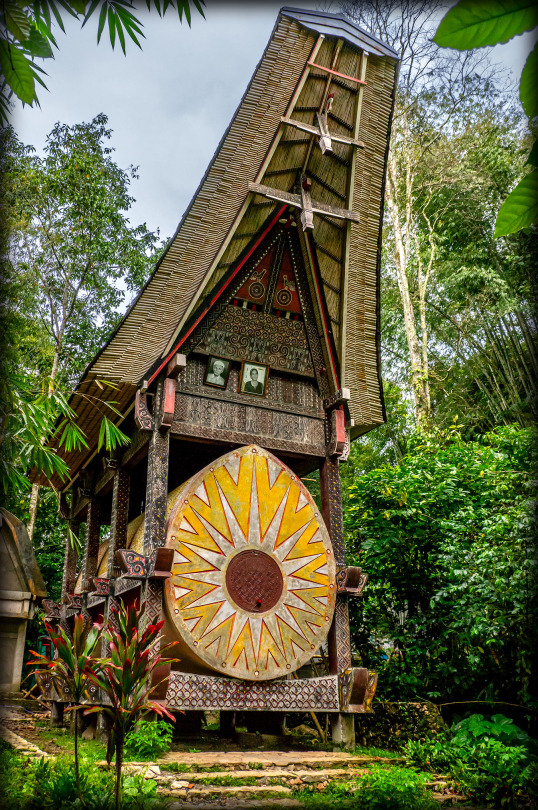
Sulawesi is an island in northern Indonesia located about 240 km east of Borneo, 430 km south of Mindanao (Philippines), 360 km west of Buru Island (Indonesian archipelago of the Moluccas), 290 km north of Flores and 600 km east-northeast of Java. With an area of 189,035 km2, it is the fourth largest island in the country but its population represents only 7% of the national total. The relief, very rugged, is mainly covered with tropical forest. The highest point of the island is Mount Rantemario with an altitude of 3,478 m.
36 notes
·
View notes
Note
I saw someone on here with the word 'insulindian' in their bio or something a while ago and i was confused and thought it must be some old fashioned word for Indonesian bc of the etymological parallel (Indonesia-> india + nessos, with nessos being greek for island, insulindia-> insula + india, with insula being latin for island) then i looked it up and saw it was from DE lol
that was the exact mental leap i made when i first played DE and i think of it every time i see 'insulindian' like it feels either like an archaic word for the indonesian archipelago or like a bizarre race science word for half-indian wasians or indians in southeast asia or something. too funny
22 notes
·
View notes
Text
A lot of those who insist that Filipinos are Pacific Islander instead of (or, in addition to) Asian often rely on loose interpretations of the term Pacific Islander and the fact that the Philippines was used as a stepping stone in the Austronesian expansion to the east. What they ignore or may not know is that (1) the superficial similarities between Pacific Islanders and Filipinos are not unique to Pacific Islanders and Filipinos but with Austronesian-speaking peoples in general, including Austronesian-speaking Southeast Asians and (2) we Filipinos simply did not have as regular and as vigorous a contact with the Pacific Islands - if any - compared to the Asian continent. We still don’t.
Think about it: the earliest known trade network in the Philippines included what is now Taiwan and Southeast Asia, i.e., the Philippine jade culture which dates as far back as 2000 BC and lasted for 3,000 years. Nephrite jade from Taiwan was manufactured in the Philippines and distributed elsewhere in the nearby region. After that were the Sa Huỳnh-Kalanay Interaction Sphere from 500 BC through AD 100 and of course the so-called Maritime Silk Road during historical times. What followed was then the very familiar colonial era of Iberian, Dutch, and British presence in Asia.
The earliest Filipino artifact with a given calendar date is the Laguna Copperplate Inscription which was written in the year AD 900 using a Brahmic script in a combination of Sanskrit, Old Malay, Old Tagalog and/or Javanese. Upon the arrival of Magellan six hundred years later in 1521, it was a man titled rajah who greeted him in Cebu. Half a century later, the aged grandson of the sultan of Brunei was ruling Manila. To this day, among the lesser Hispanicized and Americanized ethnic groups across the Philippines, the Ivatan of Batanes speak a family of languages shared with the Tao of Orchid Island, Taiwan and the people of Bangsamoro have more in common with Bruneians, Indonesians, and Malaysians than they do with the Māori, Kanaka Maoli, or Fijians. Indigenous Borneans are closely related to Filipinos.
As for myself, I was raised in Davao where you’ll find Cebuano, Ilonggo, Kagan, Maguindanaon, Maranao, Mansaka, Mandaya, Manobo, Bagobo, Chinese Hoklo, Japanese, and Indian people live; no one local I’ve ever met has identified as Pacific Islander and there was never a question as to whether I was Asian or not because I was surrounded by fellow Asians. It’s certainly hard to deny it when your country of origin is one of the founding members of the Association of Southeast Asian Nations, attempted to make a Malaysian-Filipino-Indonesian confederation happen, and contains the title “Pearl of the Orient” as a lyric in the national anthem.
Does this look like an archipelago that kept close touch with polities and cultures across the Pacific Ocean for thousands of years? Does this look like a society that is more Pacific Islander than Asian?
82 notes
·
View notes
Text
Vast arrays of solar panels floating on calm seas near the Equator could provide effectively unlimited solar energy to densely populated countries in Southeast Asia and West Africa. Our new research shows offshore solar in Indonesia alone could generate about 35,000 terawatt-hours (TWh) of solar energy a year, which is similar to current global electricity production (30,000TWh per year). And while most of the world's oceans experience storms, some regions at the Equator are relatively still and peaceful. So relatively inexpensive engineering structures could suffice to protect offshore floating solar panels. Our high-resolution global heat maps show the Indonesian archipelago and equatorial West Africa near Nigeria have the greatest potential for offshore floating solar arrays.

Continue Reading
289 notes
·
View notes
Text
The History of Petrified Wood in Indonesia
Indonesia, an archipelago rich in geological and cultural history, is home to some of the most fascinating petrified wood deposits in the world. The country's unique geological conditions have created an environment conducive to the formation of these remarkable fossils. Here's a closer look at the history and significance of petrified wood in Indonesia. Sell Petrified wood in etsy
#### Geological Background
Indonesia's location along the Pacific Ring of Fire, an area with significant volcanic activity, provides the ideal conditions for the formation of petrified wood. Volcanic eruptions, earthquakes, and the resulting sediment deposits have played a crucial role in the creation of petrified wood. Over millions of years, trees buried by volcanic ash and other sediments have undergone permineralization, resulting in the beautiful stone fossils we see today.
#### Discovery and Early Uses
The discovery of petrified wood in Indonesia dates back to ancient times, with locals finding and using these stone-like pieces in various ways. Early communities may have used petrified wood for tools, ornaments, and ceremonial objects, appreciating its durability and unique appearance.
In modern times, particularly in the 20th century, the commercial and scientific interest in petrified wood increased. Local artisans began to recognize the aesthetic and economic value of petrified wood, crafting it into jewelry, furniture, and decorative items. This trade provided a source of income for many communities and helped put Indonesian petrified wood on the global map.
#### Notable Sites
Several regions in Indonesia are renowned for their petrified wood deposits, each with its unique characteristics:
- **Banten**: Located in western Java, Banten is famous for its high-quality petrified wood. The area has yielded numerous large and well-preserved specimens, attracting both scientists and collectors. SELL ON ETSY
- **Sumatra**: The island of Sumatra, particularly the regions around Jambi and West Sumatra, has significant deposits of petrified wood. The fossils found here are often characterized by their vibrant colors and intricate patterns.
- **Kalimantan (Borneo)**: Kalimantan is another key area with rich deposits of petrified wood. The region's tropical climate and volcanic activity have contributed to the formation of diverse and well-preserved specimens.
#### Scientific and Cultural Significance
The study of petrified wood in Indonesia provides valuable insights into the region's ancient environments and climatic conditions. By examining these fossils, scientists can reconstruct past landscapes, understand vegetation changes, and gain a better understanding of the geological processes at play.
Culturally, petrified wood holds a special place in Indonesian heritage. It is often used in traditional crafts and modern art, symbolizing the connection between the natural world and human creativity. The trade and display of petrified wood also contribute to local economies, supporting artisanal communities and promoting tourism.
#### Conservation Efforts
As interest in petrified wood has grown, so too have concerns about its conservation. Over-collection and illegal mining can threaten the preservation of these natural treasures. Efforts are being made to regulate the collection and trade of petrified wood, ensuring that these fossils are protected for future generations.
#### Conclusion
Petrified wood in Indonesia is more than just a geological curiosity; it is a testament to the country's rich natural history and cultural heritage. From ancient times to the present day, these stone fossils have captivated the imagination and provided valuable resources for both scientific study and artistic expression. As efforts to conserve and protect petrified wood continue, its legacy will remain a significant part of Indonesia's story. Petrified wood bowl in etsy

#petrified wood#petrified forest national park#adventure#forest#landscape#FossilizedWood Geology NaturalHistory WoodFossil#home decor#winter#minerals#gemstones#arizona#necklace#gemstonejewelry#geology#jewellery#handmadejewelry#ilustración#ilustration
36 notes
·
View notes
Text
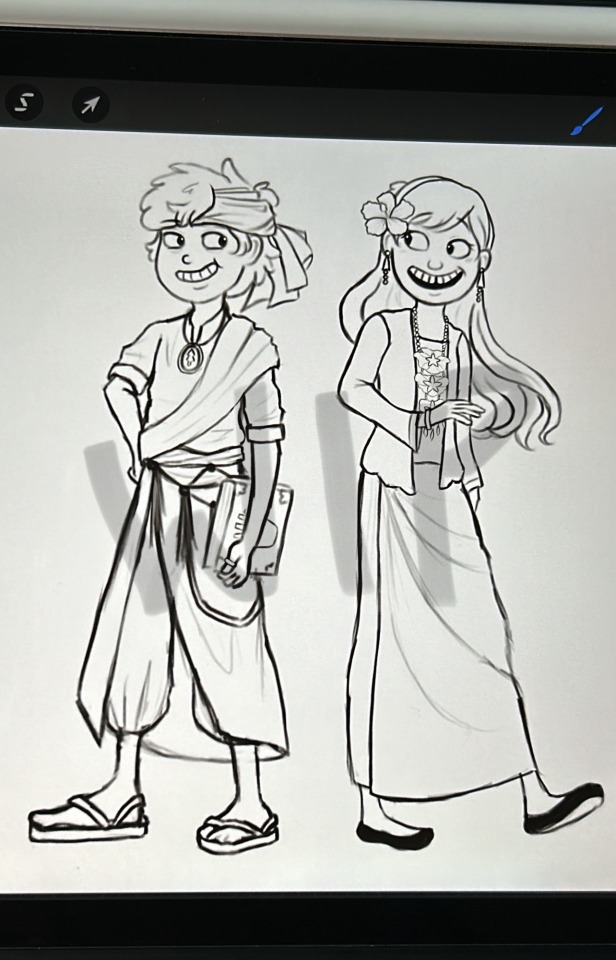
mystery twins design WIP for one of my gravity falls AUs based on my culture and its folklore!
since alex hirsch himself posted a video on twitter of a caklempong gravity falls cover i was like YEAHHH NAW I GOTTA MAKE AN AU TO REP MY CULTURE
my context: im mixed indigenous and malay+indonesian and always grew up hearing stories and reading books about folklore from the malay archipelago — so what if i just *snap🫰🏼* malayified the pines twins
based on this tweet i made a few days ago

basically the nujum pak belalang folklore is that pak belalang is a conman (in this case of my AU it's stanley) and his child belalang (in my AU the mystery twins) helps him out with his plans to become a famous fortune teller for the raja (king)
there's so many more folklores i could add maybe even design pages of ford's journals to be pages of actual creatures from my culture such as orang bunian (essentially elves) and so much more
LIKE CHAT LEMME COOK ,,,, ?!?!
33 notes
·
View notes
Text
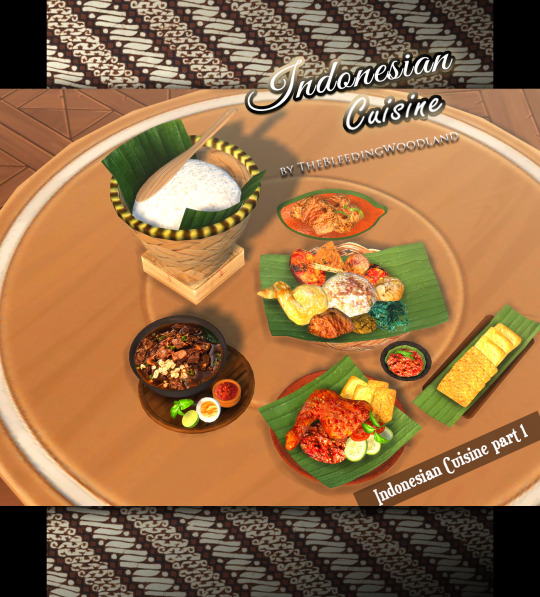
TS4 - Indonesian Cuisine (Part 1)
D E C O R A T I O N
7 Meshes converted from TS3 version.
>> LINK Part 2
>> LINK Nasi Goreng, Rendang, Sate
----------------------------------------------------
🚨[FIXED] UPDATED 15 January 2024 : All food CC were cloned and using Specular images properly, so there are no more weird dark shadow appears on food mesh 🚨Please re-download again.
Bakul Nasi has 3 swatches.

🚨UPDATED 10 DECEMBER 2023: Shadow for Bakul Nasi & Ayam Penyet fixed. 🚨
----------------------------------------------------
Indonesia merupakan negara Asia Tenggara terbesar yang kaya akan budaya, dengan beragam suku dan memiliki banyak pulau, sehingga budaya kulinernya sangat bervariasi, tidak terbatas hanya Nasi Goreng, Rendang, Sate saja. Karena banyaknya variasi makanan tersebar di Nusantara, CC dekorasi makanan ini tidak cukup untuk merepresentasikan keseluruhan makanan Indonesia yang tersebar di berbagai pulau. Selamat makan!
Indonesia is biggest Southeast Asian country that is rich of cultures, with many ethnicities and has a lot of islands, therefore has many variants of cuisine culture, not just only Nasi Goreng, Rendang, Sate. Because there are so many food variants across the archipelago, these decoration CC are not enough to represent all Indonesian cuisine that spread in many islands. Let's eat!

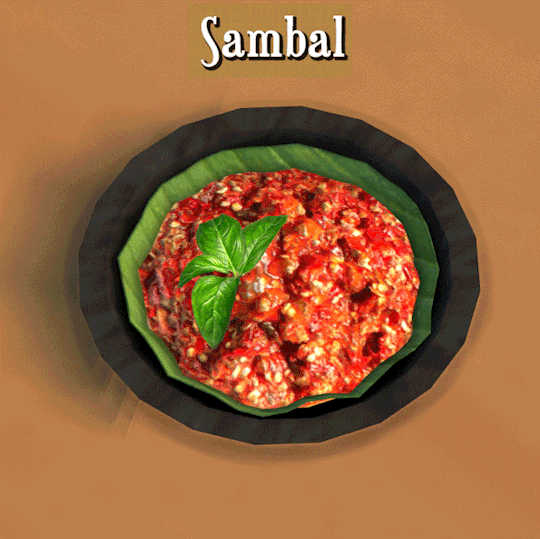
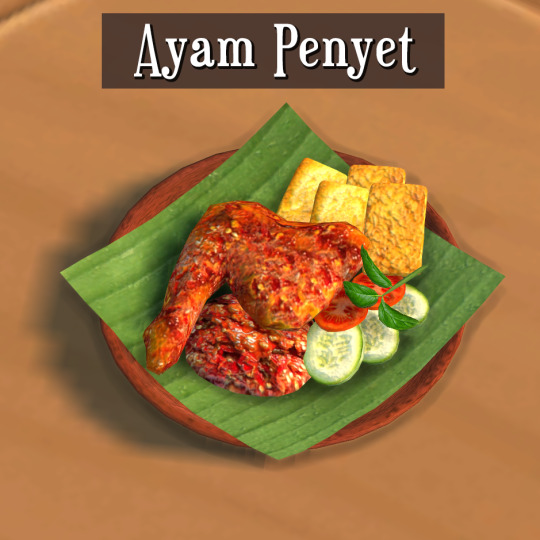
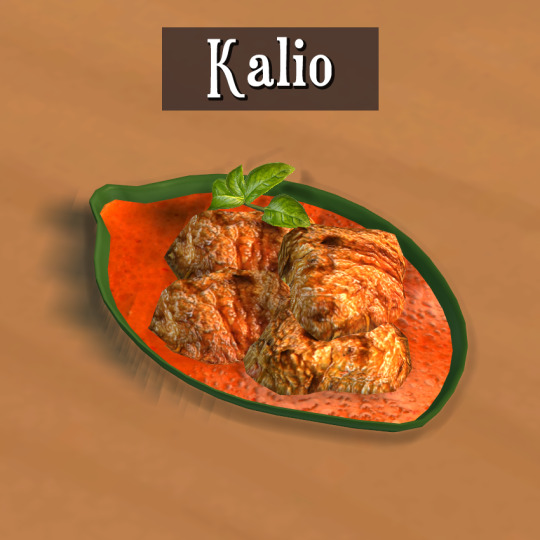


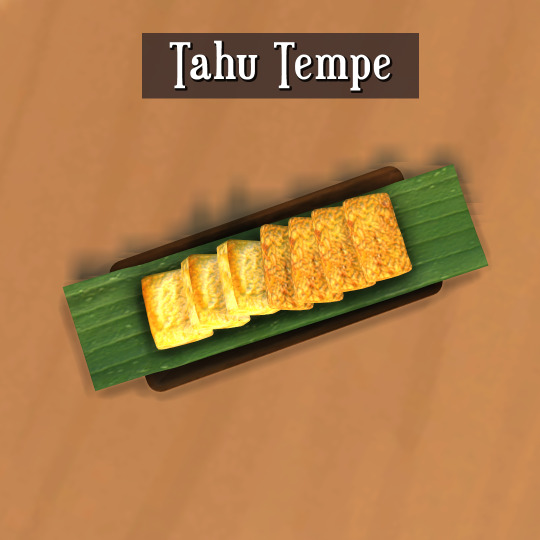
Nasi is rice in Bahasa Indonesia, which is staple food to be eaten together with lauk (dishes: consists of meat & vegetables). Indonesian food generally have Sambal option, therefore a lot of Indonesian food are served spicy.
Can be found on Decorations> Miscellaneous

[ Download ] UPDATED 15 January 2024
#the sims 4#ts4#ts4cc#indonesian food#ts4foodcc#asian food#southeastasian food#ts4dining#thebleedingwoodland#nasi#rice#sambal#ayam penyet#kalio#nasi padang#rawon#tahu tempe#ts4cc download#the sims 4 for rent
81 notes
·
View notes
Text
Unit 9: Can Trees make their own Rain?
Hi everyone,
Welcome to my Week 9 blog post!
This week, I want to share one of my favorite nature facts trees can actually create their own rain!
Introduction Forests offer much more than just habitats for wildlife and a source of oxygen; they play a crucial role in generating rainfall. This may come as a surprise, but studies indicate that forests can effectively produce their own rain through a phenomenon known as the Biotic Pump Theory.
Forests significantly influence local weather systems, playing a vital role in maintaining ecological balance and supporting diverse ecosystems. This highlights the importance of conserving our forests, not only for the wildlife that depends on them but also for the overall climate and water cycle they sustain. Protecting these natural habitats is essential for preserving both biodiversity and human life.
The Biotic Pump Theory suggests that trees can make and sustain rainful through atmospheric circulation. As trees release water vapor, they reduce atmospheric pressure over the forest. This creates a suction effect, pulling in moisture-rich air from surrounding areas. This continuous cycle helps sustain regular rainfall within the forest.
youtube
The Amazon Rainforest, one of Earth's most studied ecosystems, is a prime example of this phenomenon. Researchers have observed that rainfall begins in the Amazon two to three months before oceanic winds bring in moist air. But where does this early moisture come from? The answer lies in the trees themselves. Trees extract water from the soil through transpiration and release it into the air as water vapour. This vapour rises, cools, condenses into clouds, and eventually falls as rain.

Clouds over Amazon Rainforest
A quote that particularly resonated with me was: "In regards to mental health, experiences of awe can reduce stress and improve mood” (Green & Keltner, 2017, in Beck et al., 2018, Chapter 21). Although I’ve never had the chance to visit the Amazon Rainforest, I’ve always been captivated by its stunning beauty. A moment that truly left me in awe was my first visit to Banff, Alberta, where I experienced many breathtaking views.
NASA Data Satellite data has provided clear evidence that the moisture accumulating over the Amazon is primarily due to transpiration rather than ocean evaporation. Scientists analyzed water vapour using NASA's Aura satellite and found it contained high deuterium levels. Since ocean evaporation leaves deuterium behind, the presence of this isotope in the atmosphere of the rainforest indicates that the moisture originated from the trees, not the sea.
NASA Aura Satellite

Final Thoughts
If the Biotic Pump Theory is proven to be true, it will be essential to understand its role in regulating climate and rainfall. However, deforestation threatens this phenomenon. When vast areas of forest are cleared, the natural process of moisture transport is disrupted, leading to decreased rainfall and an increased risk of desertification. Regions that rely on the biotic pump for water could face agricultural collapse, water shortages, and the loss of vital ecosystems. These changes not only endanger local communities but also contribute to global climate instability. Therefore, it is essential to conserve these forests for future generations.
Regions that depend on The Biotic Pump: -American Southwest -African Sahel -Congo Rainforest -South Asia -Indonesian Archipelago
This week, our textbook emphasized the power of awe and how nature can inspire us to take action (Beck et al., 2018, Chapter 21). Were you in awe to learn that forests can create their own rain? Does this information make you feel compelled to take action?
Thanks for reading! Biona🌳🌧 References:
Beck, L., Cable, T. T., & Knudson, D. M. (2018). Chapter 21: The bright future of interpretation. In Interpreting cultural and natural heritage (pp. 457–467). Sagamore-Venture Publishing.
Biotic Pump Greening Group. Biotic Pump. https://www.thebioticpump.com/
Encyclopædia Britannica, inc. (2025, March 7). Amazon Rainforest. https://www.britannica.com/place/Amazon-Rainforest
Latour, M. (2019). Biotic Pump Model. SIProtectors. https://www.siprotectors.org/biopic-pump-model
The Biotic Pump. Climate Action Tai Tokerau. (2020, March 28). https://northlandclimatechange.org/the-biotic-pump/
9 notes
·
View notes
Text
One Shot, One Kill
Nobody on Earth saw it—but then again, that was the point. If humanity’s telescopes had somehow been given advance warning, they would’ve seen a brief gamma flash in the constellation of Draco—a lit match against the interstellar background, a minor course correction which flared for a few seconds before dissipating. Other than that, the intruder streaking towards the Sun left no trail. Its anti-hydrogen tanks were empty, the magnetic coil of its main engine had lain dormant for decades and its electromagnetic emissions were nothing but ghosts of ghosts. As the craft barrelled from interstellar space into the far reaches of the Solar System, the volume of dust particles increased, ionising harmlessly against the craft’s immense shields. There wasn’t a force in the universe that could dissuade it from its chosen path. It had no way of slowing down, but that wasn’t the intruder’s concern. It wasn’t going home again.
Five light-weeks from Earth, still deep in the recesses of the Oort Cloud, the intruder’s payload broke into two halves. Another gamma flare pricked at the stars as the trailing half slowed its approach by an imperceptible amount—just enough to delay interception of its target by a few hours.
Deep in the gravity well of the Solar System, the intruder’s nine billion targets continued sleeping and waking, dreaming and planning, fighting and loving, heedless of the relativistic crosshairs painted squarely on each of their heads.
** Just a few scant seconds from arrival, the leading half of the intruder’s payload burst apart, revealing a field of eight hundred flechettes. These ‘flechettes’ were nothing more than inert bullets of metal, each weighing fifteen tons and small enough to fit within the typical living room. Traveling at 91.37 percent of light-speed, each fragment carried the explosive power of the world’s nuclear arsenals more than three hundred times over. A smattering of the projectiles were diverted to impact the scattered bases on the far side of Earth’s moon. For the briefest fraction of a second, the Moon was outlined in fire: the corona of a second sun, born in the daytime skies of Earth.
Just over a second after lunar impact, the first of the relativistic flechette-bombs entered Earth’s atmosphere, forty miles off the eastern coast of Indonesia. Earth’s atmosphere produced no resistance. It would’ve been like trying to swat back a nuclear missile with a napkin.
An intense spear of light descended through the air, clearing a tunnel of near-vacuum density through which the flechette plummeted. Thirty kilometers above the waters of the Indian Ocean, the air pressure became too much—the flechette dropped another couple of halting kilometers before detonating in a flash of searing blue light, so bright that its ferocious glare wiped away every shadow in Southeast Asia. The entire eastern hemisphere of the Earth was frozen in eerie blue light, the first frame of a grisly slide. Before the human optic nerve could even react, everything in the Indonesian archipelago—every skyscraper, car, sidewalk, apartment block and beachgoer—was instantly liquefied. The skyline of Jakarta began to slip like a melting oil painting, but before it dropped half a meter, it was blasted to disparate atoms, leaving nothing but carbonized streaks across burning soil.
More than seven hundred of its sister flechettes pierced the sky in unison. Millions of square miles of ocean began to steam. From Shanghai to Sydney, from Addis Ababa to Auckland, the side of the planet facing the onslaught was now a giant microwave oven. Six billion people were boiled to vapour in the blink of an eye.
By the time the second round of projectiles reached the Earth eight hours later, every free-standing structure on the planet's surface was already burning.
#my writing#science fiction#hard science fiction#apocalyptic fiction#scifi#scifi writing#destruction scene
9 notes
·
View notes